Ming Tao
Marrying Autoregressive Transformer and Diffusion with Multi-Reference Autoregression
Jun 11, 2025Abstract:We introduce TransDiff, the first image generation model that marries Autoregressive (AR) Transformer with diffusion models. In this joint modeling framework, TransDiff encodes labels and images into high-level semantic features and employs a diffusion model to estimate the distribution of image samples. On the ImageNet 256x256 benchmark, TransDiff significantly outperforms other image generation models based on standalone AR Transformer or diffusion models. Specifically, TransDiff achieves a Fr\'echet Inception Distance (FID) of 1.61 and an Inception Score (IS) of 293.4, and further provides x2 faster inference latency compared to state-of-the-art methods based on AR Transformer and x112 faster inference compared to diffusion-only models. Furthermore, building on the TransDiff model, we introduce a novel image generation paradigm called Multi-Reference Autoregression (MRAR), which performs autoregressive generation by predicting the next image. MRAR enables the model to reference multiple previously generated images, thereby facilitating the learning of more diverse representations and improving the quality of generated images in subsequent iterations. By applying MRAR, the performance of TransDiff is improved, with the FID reduced from 1.61 to 1.42. We expect TransDiff to open up a new frontier in the field of image generation.
Replace in Translation: Boost Concept Alignment in Counterfactual Text-to-Image
May 20, 2025Abstract:Text-to-Image (T2I) has been prevalent in recent years, with most common condition tasks having been optimized nicely. Besides, counterfactual Text-to-Image is obstructing us from a more versatile AIGC experience. For those scenes that are impossible to happen in real world and anti-physics, we should spare no efforts in increasing the factual feel, which means synthesizing images that people think very likely to be happening, and concept alignment, which means all the required objects should be in the same frame. In this paper, we focus on concept alignment. As controllable T2I models have achieved satisfactory performance for real applications, we utilize this technology to replace the objects in a synthesized image in latent space step-by-step to change the image from a common scene to a counterfactual scene to meet the prompt. We propose a strategy to instruct this replacing process, which is called as Explicit Logical Narrative Prompt (ELNP), by using the newly SoTA language model DeepSeek to generate the instructions. Furthermore, to evaluate models' performance in counterfactual T2I, we design a metric to calculate how many required concepts in the prompt can be covered averagely in the synthesized images. The extensive experiments and qualitative comparisons demonstrate that our strategy can boost the concept alignment in counterfactual T2I.
Do We Need to Design Specific Diffusion Models for Different Tasks? Try ONE-PIC
Dec 07, 2024Abstract:Large pretrained diffusion models have demonstrated impressive generation capabilities and have been adapted to various downstream tasks. However, unlike Large Language Models (LLMs) that can learn multiple tasks in a single model based on instructed data, diffusion models always require additional branches, task-specific training strategies, and losses for effective adaptation to different downstream tasks. This task-specific fine-tuning approach brings two drawbacks. 1) The task-specific additional networks create gaps between pretraining and fine-tuning which hinders the transfer of pretrained knowledge. 2) It necessitates careful additional network design, raising the barrier to learning and implementation, and making it less user-friendly. Thus, a question arises: Can we achieve a simple, efficient, and general approach to fine-tune diffusion models? To this end, we propose ONE-PIC. It enhances the inherited generative ability in the pretrained diffusion models without introducing additional modules. Specifically, we propose In-Visual-Context Tuning, which constructs task-specific training data by arranging source images and target images into a single image. This approach makes downstream fine-tuning closer to the pertaining, allowing our model to adapt more quickly to various downstream tasks. Moreover, we propose a Masking Strategy to unify different generative tasks. This strategy transforms various downstream fine-tuning tasks into predictions of the masked portions. The extensive experimental results demonstrate that our method is simple and efficient which streamlines the adaptation process and achieves excellent performance with lower costs. Code is available at https://github.com/tobran/ONE-PIC.
Multimodal Emotion Recognition with Vision-language Prompting and Modality Dropout
Sep 11, 2024Abstract:In this paper, we present our solution for the Second Multimodal Emotion Recognition Challenge Track 1(MER2024-SEMI). To enhance the accuracy and generalization performance of emotion recognition, we propose several methods for Multimodal Emotion Recognition. Firstly, we introduce EmoVCLIP, a model fine-tuned based on CLIP using vision-language prompt learning, designed for video-based emotion recognition tasks. By leveraging prompt learning on CLIP, EmoVCLIP improves the performance of pre-trained CLIP on emotional videos. Additionally, to address the issue of modality dependence in multimodal fusion, we employ modality dropout for robust information fusion. Furthermore, to aid Baichuan in better extracting emotional information, we suggest using GPT-4 as the prompt for Baichuan. Lastly, we utilize a self-training strategy to leverage unlabeled videos. In this process, we use unlabeled videos with high-confidence pseudo-labels generated by our model and incorporate them into the training set. Experimental results demonstrate that our model ranks 1st in the MER2024-SEMI track, achieving an accuracy of 90.15% on the test set.
StoryImager: A Unified and Efficient Framework for Coherent Story Visualization and Completion
Apr 09, 2024
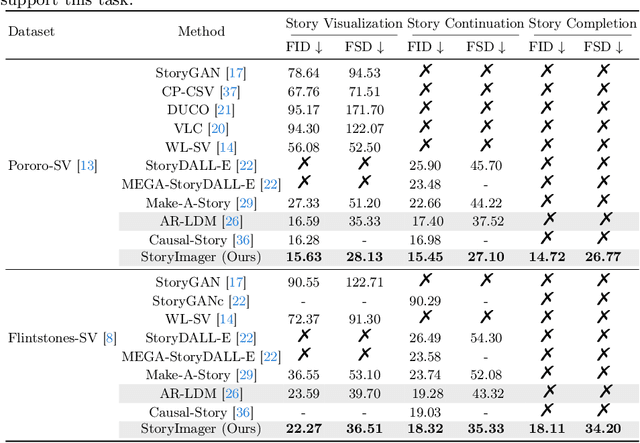

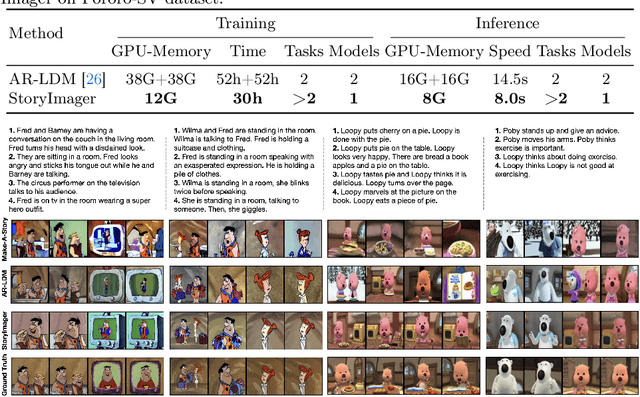
Abstract:Story visualization aims to generate a series of realistic and coherent images based on a storyline. Current models adopt a frame-by-frame architecture by transforming the pre-trained text-to-image model into an auto-regressive manner. Although these models have shown notable progress, there are still three flaws. 1) The unidirectional generation of auto-regressive manner restricts the usability in many scenarios. 2) The additional introduced story history encoders bring an extremely high computational cost. 3) The story visualization and continuation models are trained and inferred independently, which is not user-friendly. To these ends, we propose a bidirectional, unified, and efficient framework, namely StoryImager. The StoryImager enhances the storyboard generative ability inherited from the pre-trained text-to-image model for a bidirectional generation. Specifically, we introduce a Target Frame Masking Strategy to extend and unify different story image generation tasks. Furthermore, we propose a Frame-Story Cross Attention Module that decomposes the cross attention for local fidelity and global coherence. Moreover, we design a Contextual Feature Extractor to extract contextual information from the whole storyline. The extensive experimental results demonstrate the excellent performance of our StoryImager. The code is available at https://github.com/tobran/StoryImager.
A Heterogeneous Parallel Non-von Neumann Architecture System for Accurate and Efficient Machine Learning Molecular Dynamics
Mar 26, 2023Abstract:This paper proposes a special-purpose system to achieve high-accuracy and high-efficiency machine learning (ML) molecular dynamics (MD) calculations. The system consists of field programmable gate array (FPGA) and application specific integrated circuit (ASIC) working in heterogeneous parallelization. To be specific, a multiplication-less neural network (NN) is deployed on the non-von Neumann (NvN)-based ASIC (SilTerra 180 nm process) to evaluate atomic forces, which is the most computationally expensive part of MD. All other calculations of MD are done using FPGA (Xilinx XC7Z100). It is shown that, to achieve similar-level accuracy, the proposed NvN-based system based on low-end fabrication technologies (180 nm) is 1.6x faster and 10^2-10^3x more energy efficiency than state-of-the-art vN based MLMD using graphics processing units (GPUs) based on much more advanced technologies (12 nm), indicating superiority of the proposed NvN-based heterogeneous parallel architecture.
GALIP: Generative Adversarial CLIPs for Text-to-Image Synthesis
Jan 30, 2023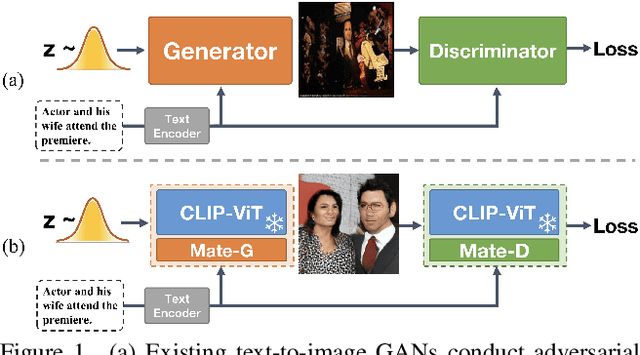
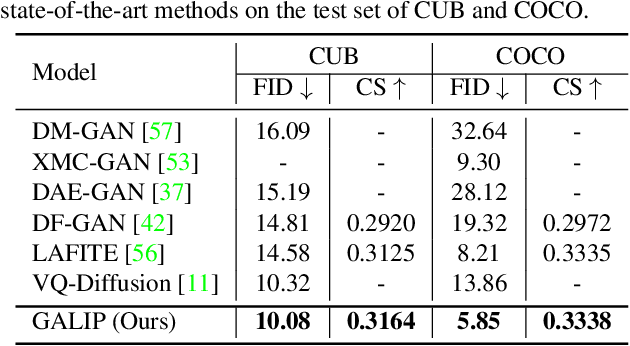

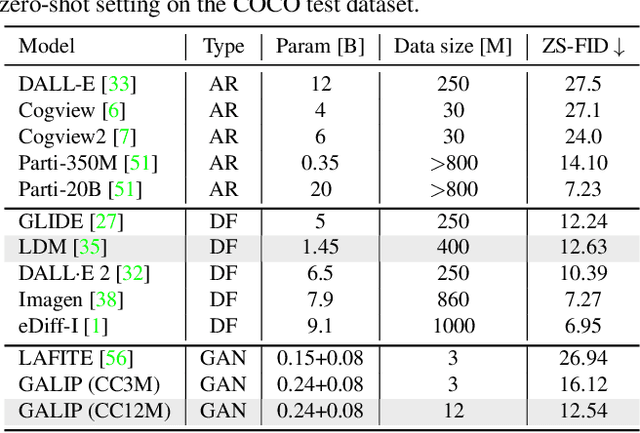
Abstract:Synthesizing high-fidelity complex images from text is challenging. Based on large pretraining, the autoregressive and diffusion models can synthesize photo-realistic images. Although these large models have shown notable progress, there remain three flaws. 1) These models require tremendous training data and parameters to achieve good performance. 2) The multi-step generation design slows the image synthesis process heavily. 3) The synthesized visual features are difficult to control and require delicately designed prompts. To enable high-quality, efficient, fast, and controllable text-to-image synthesis, we propose Generative Adversarial CLIPs, namely GALIP. GALIP leverages the powerful pretrained CLIP model both in the discriminator and generator. Specifically, we propose a CLIP-based discriminator. The complex scene understanding ability of CLIP enables the discriminator to accurately assess the image quality. Furthermore, we propose a CLIP-empowered generator that induces the visual concepts from CLIP through bridge features and prompts. The CLIP-integrated generator and discriminator boost training efficiency, and as a result, our model only requires about 3% training data and 6% learnable parameters, achieving comparable results to large pretrained autoregressive and diffusion models. Moreover, our model achieves 120 times faster synthesis speed and inherits the smooth latent space from GAN. The extensive experimental results demonstrate the excellent performance of our GALIP. Code is available at https://github.com/tobran/GALIP.
DE-Net: Dynamic Text-guided Image Editing Adversarial Networks
Jun 02, 2022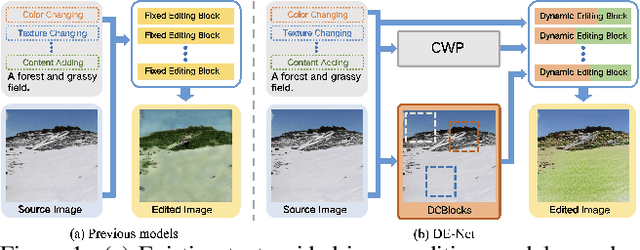

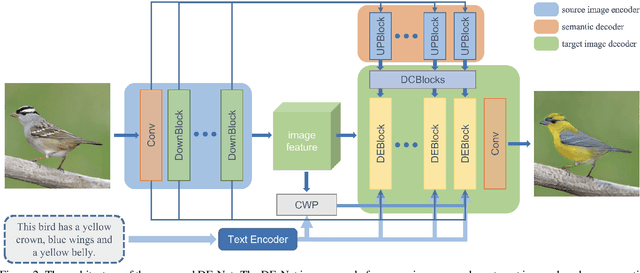

Abstract:Text-guided image editing models have shown remarkable results. However, there remain two problems. First, they employ fixed manipulation modules for various editing requirements (e.g., color changing, texture changing, content adding and removing), which result in over-editing or insufficient editing. Second, they do not clearly distinguish between text-required parts and text-irrelevant parts, which leads to inaccurate editing. To solve these limitations, we propose: (i) a Dynamic Editing Block (DEBlock) which combines spatial- and channel-wise manipulations dynamically for various editing requirements. (ii) a Combination Weights Predictor (CWP) which predicts the combination weights for DEBlock according to the inference on text and visual features. (iii) a Dynamic text-adaptive Convolution Block (DCBlock) which queries source image features to distinguish text-required parts and text-irrelevant parts. Extensive experiments demonstrate that our DE-Net achieves excellent performance and manipulates source images more effectively and accurately. Code is available at \url{https://github.com/tobran/DE-Net}.
DF-GAN: Deep Fusion Generative Adversarial Networks for Text-to-Image Synthesis
Aug 13, 2020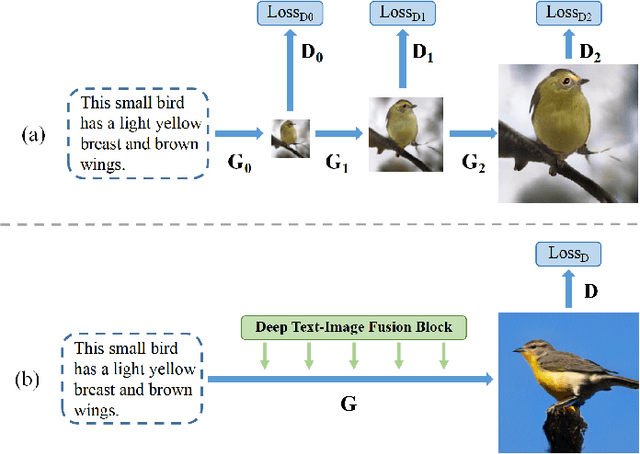
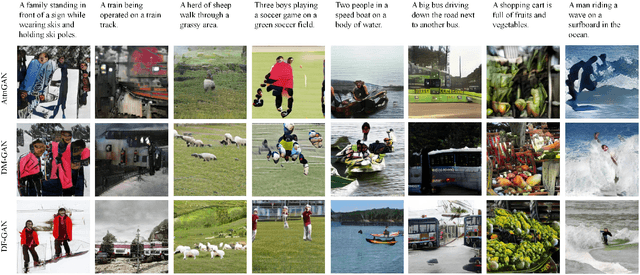
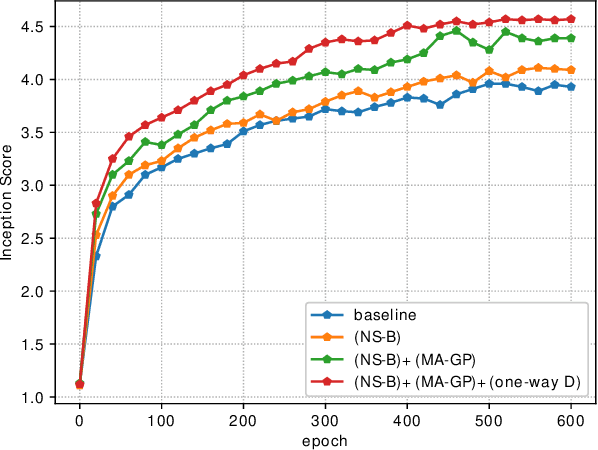
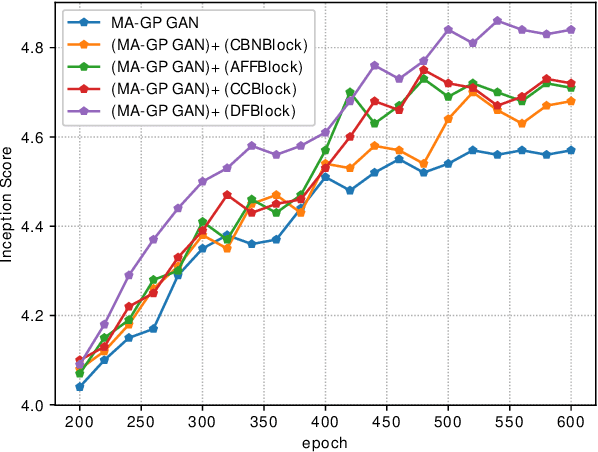
Abstract:Synthesizing high-resolution realistic images from text descriptions is a challenging task. Almost all existing text-to-image methods employ stacked generative adversarial networks as the backbone, utilize cross-modal attention mechanisms to fuse text and image features, and use extra networks to ensure text-image semantic consistency. The existing text-to-image models have three problems: 1) For the backbone, there are multiple generators and discriminators stacked for generating different scales of images making the training process slow and inefficient. 2) For semantic consistency, the existing models employ extra networks to ensure the semantic consistency increasing the training complexity and bringing an additional computational cost. 3) For the text-image feature fusion method, cross-modal attention is only applied a few times during the generation process due to its computational cost impeding fusing the text and image features deeply. To solve these limitations, we propose 1) a novel simplified text-to-image backbone which is able to synthesize high-quality images directly by one pair of generator and discriminator, 2) a novel regularization method called Matching-Aware zero-centered Gradient Penalty which promotes the generator to synthesize more realistic and text-image semantic consistent images without introducing extra networks, 3) a novel fusion module called Deep Text-Image Fusion Block which can exploit the semantics of text descriptions effectively and fuse text and image features deeply during the generation process. Compared with the previous text-to-image models, our DF-GAN is simpler and more efficient and achieves better performance. Extensive experiments and ablation studies on both Caltech-UCSD Birds 200 and COCO datasets demonstrate the superiority of the proposed model in comparison to state-of-the-art models.
SiENet: Siamese Expansion Network for Image Extrapolation
Jul 08, 2020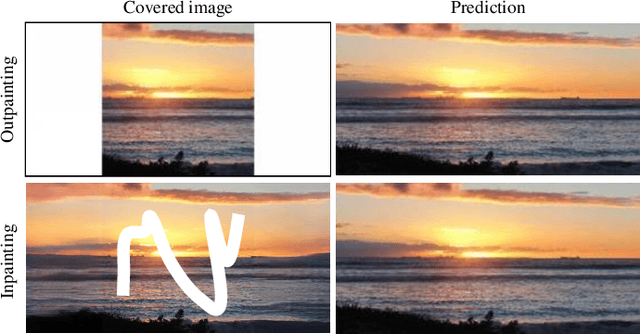

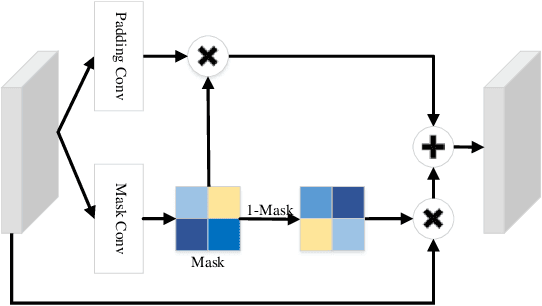
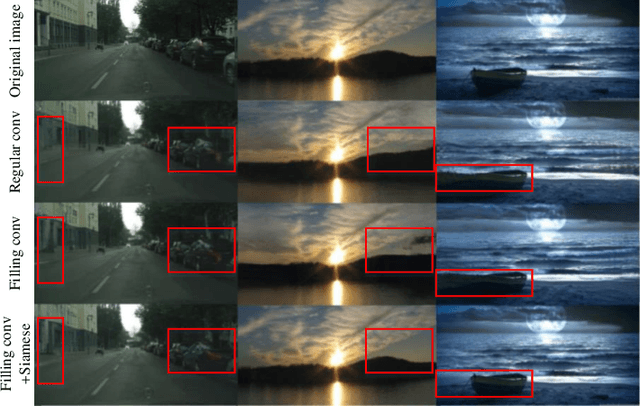
Abstract:Different from image inpainting, image outpainting has relative less context in the image center to capture and more content at the image border to predict. Therefore, classical encoder-decoder pipeline of existing methods may not predict the outstretched unknown content perfectly. In this paper, a novel two-stage siamese adversarial model for image extrapolation, named Siamese Expansion Network (SiENet) is proposed. In two stages, a novel border sensitive convolution named adaptive filling convolution is designed for allowing encoder to predict the unknown content, alleviating the burden of decoder. Besides, to introduce prior knowledge to network and reinforce the inferring ability of encoder, siamese adversarial mechanism is designed to enable our network to model the distribution of covered long range feature for that of uncovered image feature. The results on four datasets has demonstrated that our method outperforms existing state-of-the-arts and could produce realistic results.
 Add to Chrome
Add to Chrome Add to Firefox
Add to Firefox Add to Edge
Add to Edge